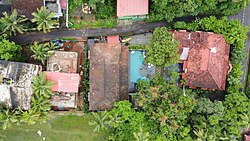This article needs additional citations for verification .(September 2018) |
Bastora | |
|---|---|
village | |
 Aerial views of the village | |
| Coordinates: 15°35′N73°49′E / 15.583°N 73.817°E | |
| Country | |
| State | Goa |
| District | North Goa |
| Languages | |
| • Official | Konkani |
| Time zone | UTC+5:30 (IST) |
| Vehicle registration | GA |
| Nearest city | Mapusa |
| Website | goa |
Bastora is a village in North Goa, India. It is located on the outskirts of Mapusa town. Green and still scenic, this is one of the many communities and villages that makes up mainly-rural, but fast-urbanising Goa.

